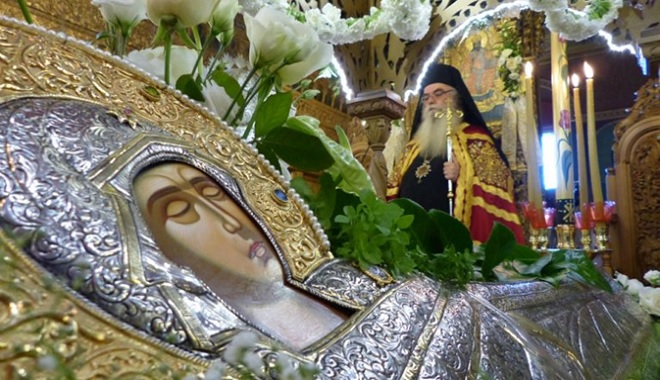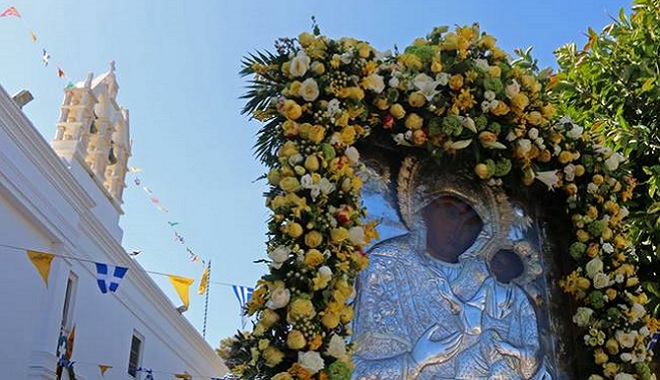The Dormition of the Mother of God
15 August 2023In the hymnography of the Orthodox Church, the Mother of God is called ‘god after God, holding second position to the Trinity’. Some people may feel that these terms are excessive and dogmatically unfounded. This is certainly not the case, however, since they convey the quintessence of Orthodox theology and anthropology.
The Mother of God isn’t merely the first but also the only person who effectively collaborated in the execution of the redemptive plan of divine providence. She’s the only ‘agent of blessings beyond nature’ [1]. Her response to the Archangel Gabriel’s salutation was the beginning of the ontological process for the salvation and renewal of the human race and the whole of creation.

Human ‘collaboration’ which is, in essence, the starting-point for Orthodox dogmatic teaching, isn’t just a moral but also an ontological requirement for our salvation. God doesn’t save us without our ‘collaboration’, that is our cooperation. Our free consent to and participation in this task are a requirement, and this is fulfilled with the collaboration of the Mother of God in the plan of divine providence. Without the presence of the Mother of God and her overall participation in the plan of divine providence, the salvation and renewal of the world would have remained in abeyance.
As Saint Nikolaos Kavasilas observes, just as it was Christ’s will to become a human person, so it was necessary for the Virgin to become his mother with her freely-given consent. And then, the Savior wasn’t a person and the Son of Man just because of his flesh; he also had a soul, mind and will, that is, everything human. This means that his mother would also have to be perfect, since she was to serve in bearing not just the nature of his body, but also his mind and will, with everything he had as a human being. In other words, the Mother of God had to offer the whole of herself to God, spiritually and bodily, so that God could save the whole human person [2].
Our Lady didn’t come from heaven but from earth, in the same manner as the rest of our fallen race, which had forgotten its own true nature. Our Lady, however, resisted all wickedness and, with great gratitude exercised virtue, giving herself entirely to God [3]. So we might say that the dogmatic meaning of human collaboration is epitomized, in its most perfect form, in the person of our Lady. As Kavasilas remarks, however, the Virgin wasn’t like the earth which contributed to the formation of the first human being simply by being the unwitting material used by the Creator. Instead, she worked and herself offered to God all those things which drew the Creator down to earth [4].
By her free and overall contribution to the task of salvation and renewal, the Virgin became a co-author and mother of the ‘new creation’. ‘Where is the new creation from? Who altered all things, therefore?’ asks Kavasilas, and he goes on to say that, of course, heaven received new, reborn citizens whom the Virgin had conveyed there from the earth [5].
At the feast of the dormition of the Mother of God, and, indeed, at the feast of every saint of the Church, we do something which seems strange: we celebrate their death. We do this, not because we’re happy about the death, but because we rejoice in the power which the Church gives us to overcome death. We celebrate it as a temporary sleep. We celebrate it not as a descent into hell but as an ascent into heaven.
But particularly at the feast of the dormition of the Mother of God we commemorate, or rather celebrate, the most holy and strange falling asleep of any human being: the dormition of the Mother of God, the Mother of life. And we celebrate it not as an event which has to do only with our Lady, but with all of us; each and every one of us.
We’re all mortal, just as our Lady was. We’ve all received God’s gift of experiencing death as dormition in the Church. This is a gift which was first put into effect with our Lady because of her willing consent to God’s invitation at the Annunciation to bear Christ: ‘Behold, your handmaiden. May it be to me in accordance with your word’ [6].

Through this absolute obedience of hers, our Lady rooted the Church in the world as a theanthropic community and made the gift of the victory over death available to all of us. So Pentecost, the birthday of Christ’s Church, essentially begins on the day of the Annunciation. It starts with the inauguration of the community of glorification, within which death is abolished and true life reigns.
If Christ is the author of the salvation and sanctification of the world, our Lady is the ‘co-author’. But Christ, who was given birth ‘once in the flesh’ by our Lady, is also being born constantly ‘in the Spirit’ by love towards everyone who is willing to welcome him. He becomes an infant and is given form in the faithful with the virtues [7]. By the same token, the faithful take the place of our Lady in spiritual terms and, by the grace of the Holy Spirit, become the mother of Christ, just as they become his siblings and members of his body with their entry into the Church and their participation in baptism and holy communion.
Christ himself said: ‘My mother and my brethren are those who hear the word of God and keep it’[8]. As for Christ, so for our Lady and for every Christian, death isn’t the end of life; it isn’t obliteration. It’s a falling asleep and entry into a new life, true life, eternal life. This is why, as it says in the canon sung at her Dormition ‘in dying she is raised with her Son, living eternally’ [9]. As the mother of Life, she lives eternal life with the Lord of Life. In the same way, believers who live with faith in Christ, in the Church, enter a new prospect of immortal and heavenly life when they die.






